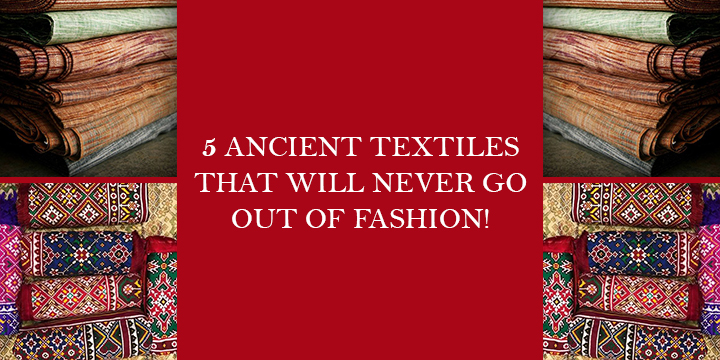
5 ANCIENT TEXTILES THAT WILL NEVER GO OUT OF FASHION!
5 ANCIENT TEXTILES THAT WILL NEVER GO OUT OF FASHION!
Since ancient times, India has been known for its textiles. Indian textiles can be dated back to the 5th millennium BC, to the Indus valley civilization. The people of that culture constructed their garments with homespun cotton and dyed their fabric with indigo. Textiles have traditionally been essential in Indian trade and commerce. Indian textiles have been discovered in China, Rome, and Egypt, among other places. With hundreds of strands weaving and producing the most magnificent fabrics that captivate our gaze, India can be considered a textile hub. Down below are five prehistoric textiles that will always be à la mode.
KHADI
When the Boycott movement in India began, the first Khadi textile was created. Khadi is a natural fiber textile that is spun and woven by hand. Gandhi Ji believed that this handcrafted Khadi textile would bring about positive transformations in people’s lives. Hence, he inspired and encouraged the public to weave their own yarn and proudly wear it in order to preserve the country’s traditions. During British rule, it was known as khaddar and depicted solely Indian or swadeshi fabrics. Fibers are spun into yarn on a spinning wheel known as a charkha. Khadi is a multifunctional fabric that can be worn in all seasons. Its lightweight property will keep you fresh in summer, while its texture will keep you warm in the winter.

BANARASI SILK
Banarasi silk is undoubtedly a mesmerizing classic. Its appearance is overwhelmingly royal, and the richness in its texture answers why it is constantly in fashion. Gold and silver brocade or zari, exquisite silk, and excellent needlework are all hallmarks of Banarasi silk. The highly famous banarasi silk sari is embellished with Mughal-inspired designs, including floral and botanical motifs, fruit motifs, and minakari work. The custom of passing down the Banarasi saris’ artistic culture from generation to generation has never been broken. Banarasi sarees are currently available in only four distinct kinds. The most important are Banarasi silks. They also come in kora and organza. The Banarasi silks can be further classified into six more categories based on the work and motifs, namely Jangla, Tanchoi, Tissue, Butidar, Cutwork, Vaskat, and, Jamdani.

IKAT
Ikat is a complex dyeing technique that uses silk or cotton textiles. The end product is a piece of fabric that is drenched in vibrant colors. Before the material is weaved, the ikat designs are dyed and fused into the strands. This separates it from the Tie and Dye procedure, in which the fabric is woven first. The geometric pattern and deliberate bleed distinguish the double ikat textiles. Resist Dyeing is the procedure employed to do this. As the name suggests, Resist Dyeing resists dye from spreading all over the fabric.

PATOLA
Patola is a double ikat textile, typically made from silk. Patola, also known as the “Queen of Silks,” is woven with exceptional care and delicacy. Each patola sari can take anywhere from six months to a year due to its labor-intensive character. Patola’s value stems from its complexity and time allocation. Patola saris are braided using dyed threads both through the warp and weft to form the design, which involves intense mathematical calculations.

BANDHANI
The word Bandhani originated from the Sanskrit word ‘Banda,’ which denotes ‘to tie.’ It is mainly performed in Rajasthan, Gujarat, and some portions of Uttar Pradesh. Bandhani is an art that uses the tie-and-dye process. In this, the fabric is knotted up into tiny points with strings, and the knotted sections are left uncolored when dyed. Bandhej is another name for it. It can be created on superfine cotton, mulmul, and muslin materials. Mirror work and thread work is used to highlight the bandhani print further.

Related Articles:-
Categories: AJRAKH PRINT, BAGH PRINT, Decorative Jewellery, Different prints, Festival Season, Indian Wedding Collection Articles, Traditional Indian Dresses Articles
Sorry, comments are closed for this item.
